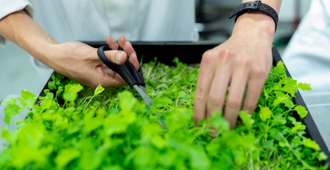The professor of Plant Physiology María Ángeles Pedreño and the doctor Ana Belén Sabater are at the spearhead of a regional agricultural science capable of combining a high international level with a discordant lack of financing. In these lines they explain their work and the vision of the moment that this activity is going through.
–What is the investigation in which you are immersed?
–We are finishing the field tests with the lettuces of a project financed by the Seneca Foundation. It is a proof of concept in which a product has been developed. In this case, it is a biostimulant that promotes plant growth, and also protects them, to a certain extent, from fungal infections. It is developed in collaboration with the company Agrométodos, which has been in charge of the design of the formulation and helps us in the studies in the field. Another project that we are developing in collaboration with the company Semilleros del Sureste is financed with funds from the Ministry of Science and Innovation. It is a subsidy awarded to the company through the CDTI (acronym for Center for Technological and Industrial Development) and which has a contract associated with our research group. This project is also based on obtaining formulations that act as stimulants for the germination and growth processes of plants, in this case plants from the brassica family, such as broccoli, cauliflower, kohlrabi or cabbage.
The precariousness and temporary nature of the contracts of young scientists must be reduced
– What benefits for the agricultural sector can be extracted from these investigations?
–The two projects were selected to be financed due to their innovation and their social and economic impact. The formulations use extracts from other plants (such as thyme, vines or carrots, among others) that stand out for having an arsenal of defense compounds that make them more resistant to unfavorable weather conditions and protect them from attack by fungal infections. Among the results we are obtaining is a preview of the germination of broccoli, kohlrabi and cauliflower. We are also observing an increase in tolerance to unfavorable conditions, mainly salinity, in these plants treated and grown in the greenhouse. This advance in germination is beneficial for the farmer since it represents an advance in the placing on the market of his products and the possibility of using saline soils for cultivation, which are characteristic of some areas of our Region. These brassica crops treated with biostimulants also represent a benefit for the consumer since by raising the defenses in these plants, chemical treatments are not required to combat the pests that threaten the crops, thus resembling organic crops.
–Has the pandemic changed our vision of science?
– Fundamentally what has changed is our way of life. Now there is greater awareness for everything related to health. That includes food. A sustainable agriculture such as the one that is intended to be achieved with the development of these projects contributes significantly to the well-being of society. It is true that society values research much more, especially that focused on health. And the importance that the agri-food industry has given to research is also noteworthy, since in this post-pandemic stage there has been a greater rapprochement of companies towards researchers.
–In this context, there is talk of initiatives aimed at increasing investment in science. Does this sound sincere to you, or do you think it’s just marketing that won’t make much of a difference?
–Although it is true that in the calls for national projects related to agriculture there has been an increase in the budget, this continues to be much lower than that assigned to areas related to health. The problem is that the initiatives aimed at increasing investment in science depend on our politicians, and therefore many of them are not implemented due to a lack of consensus or due to changes in government agreements. For this reason, for the moment, we have not observed significant changes.
European funding received for field studies in agriculture is very low
–What do we need to be able to finance good science?
–On the one hand, that the financing of science be considered independently of political interests, regardless of the party that governs the State or the Region. As our vice-rector for Scientific Transfer and Dissemination, José Manuel López Nicolás, very well described, at the delivery of the National Research Awards “we are facing a historic opportunity to make something a reality that scientists have been demanding for years and that has never been realized.” has achieved: the signing of a State pact for science that ensures, whoever governs, investment in science is always assured». On the other hand, it is necessary that, in the reform of the Law on Science, Technology and Innovation, which is being carried out, we manage to stabilize and retain our young scientists. The precariousness and temporary nature of their contracts must be reduced. They are our generational relay and the future of research in our research centers and universities.
– Is the Region of Murcia really at the forefront of global agricultural scientific research, as is so often heard?
– I believe that the Region of Murcia is at the forefront of scientific research in the agricultural sector. At least at the European level. Not only is there a powerful contribution from public and private universities in the Region, but we also have centers of recognized prestige that are making relevant advances in this sector, such as Cebas and Imida. However, the European funding received for carrying out research in the field of agriculture is very scarce. The reason is not that we are uncompetitive. The problem resides in the need to establish a good consortium of researchers and companies that are really interested in research. We also need the support of agents or companies to help us carry out and present this type of project in an attractive way. Despite the fact that we have a European Projects Office that offers information and advice to the research groups of the University of Murcia, on aspects related to participation in European projects.


